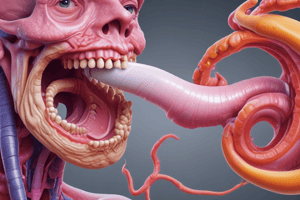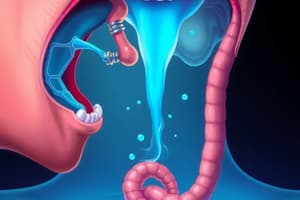Podcast
Questions and Answers
Which type of vomiting indicates bleeding in the stomach or intestine?
Which type of vomiting indicates bleeding in the stomach or intestine?
- Yellow vomit
- Frank blood vomit
- Deep brown vomit
- Coffee grounds vomit (correct)
What does frank blood in stool indicate?
What does frank blood in stool indicate?
- Digestive process breaking down blood
- Presence of hemoglobin in the stool
- Bleeding higher in the intestinal tract
- Bleeding in the anal canal or rectum (correct)
What causes achalasia in dysphagia?
What causes achalasia in dysphagia?
- Disconnection of esophagus segments
- Failure of the lower esophageal sphincter to relax (correct)
- Presence of a tumor compressing the esophagus
- Narrowing of the esophagus
Which of the following is a symptom of GERD?
Which of the following is a symptom of GERD?
What type of hiatal hernia affects the whole circumference of the esophagus?
What type of hiatal hernia affects the whole circumference of the esophagus?
Which of the following is NOT a cause of acute gastritis?
Which of the following is NOT a cause of acute gastritis?
How can melena be best described?
How can melena be best described?
Which treatment is commonly used for GERD?
Which treatment is commonly used for GERD?
Flashcards
Vomiting Characteristics
Vomiting Characteristics
Vomiting patterns and contents help diagnose digestive issues.
Blood in Stool (Melena)
Blood in Stool (Melena)
Dark stool resulting from bleeding higher in the digestive tract.
Dysphagia
Dysphagia
Difficulty or inability to swallow.
Hiatal Hernia
Hiatal Hernia
Signup and view all the flashcards
GERD (Gastroesophageal Reflux)
GERD (Gastroesophageal Reflux)
Signup and view all the flashcards
Acute Gastritis
Acute Gastritis
Signup and view all the flashcards
Chronic Gastritis
Chronic Gastritis
Signup and view all the flashcards
Anorexia/Nausea/Vomiting Causes
Anorexia/Nausea/Vomiting Causes
Signup and view all the flashcards
Study Notes
Digestive System Symptoms
-
Anorexia, nausea, and vomiting can signal digestive issues or systemic problems like infections or kidney failure.
-
Vomiting characteristics are helpful in diagnosis. Coffee-ground vomit suggests stomach bleeding, yellow vomit usually comes from the duodenum, deep brown vomit from the jejunum/ileum, and visible blood (frank blood) suggests issues like gastric emptying problems or pyloric obstruction.
Blood in Stool
- Frank blood in stool indicates bleeding in the anal canal or rectum.
- Melena, dark stool, suggests bleeding higher in the digestive tract, often in the large intestine. This darkening occurs due to digestion.
- Occult blood, hidden blood, needs special tests to detect it.
Dysphagia (Difficulty Swallowing)
- Causes include neurological issues, muscular problems, and mechanical obstructions.
- Specific types of dysphagia include achalasia (esophageal sphincter failure to relax), congenital atresia (disconnected upper/ lower esophagus), stenosis (narrowed esophagus), diverticulum (food trapped in a blind pouch), and esophageal tumors (internal or external compression).
Hiatal Hernia and GERD
- Hiatal hernia is where the esophagus passes through the diaphragm. Axial hiatal hernias affect the whole circumference of the esophagus while para-esophageal affect one side.
- GERD (Gastroesophageal Reflux Disease) involves stomach contents flowing back into the esophagus, causing burning typically 30-60 minutes after eating.
Stomach Disorders
- Acute gastritis involves inflammation of the stomach lining, often caused by aspirin/NSAIDs, chemotherapy, alcohol, or gastric radiation. It is often temporary.
- Chronic gastritis is long-term inflammation, commonly caused by H. pylori infections or autoimmune disorders that attack the stomach's parietal cells. This can lead to B12 deficiency.
Ulcerative Disorders
- Peptic ulcer disease involves breakdown of the stomach lining, most commonly found in the duodenum, possible causes include H. Pylori.
- Gastric ulcers can also form in the stomach, often caused by H. Pylori or NSAID abuse.
Inflammatory Conditions
- Inflammatory Bowel Disease (IBD) includes Crohn's disease and ulcerative colitis. Crohn's affects the entire GI tract while ulcerative colitis is limited to the large intestine (mucosa only). Both can cause pain (often alternating with remission) and problems like diarrhea, abdominal pain, or rectal bleeding.
- Crohn's disease can affect multiple parts of the digestive tract from mouth to anus, and can impact the inner layers of the walls.
- Ulcerative colitis commonly occurs in the descending colon, sigmoid colon and rectum with increasing risk of colon cancer. It's typically characterized by easily bleeding tissue.
Peritonitis
- Peritonitis inflammatory condition of the peritoneum (lining of the abdomen). It can be caused by various factors, and treatment often involves eliminating the cause.
Studying That Suits You
Use AI to generate personalized quizzes and flashcards to suit your learning preferences.




